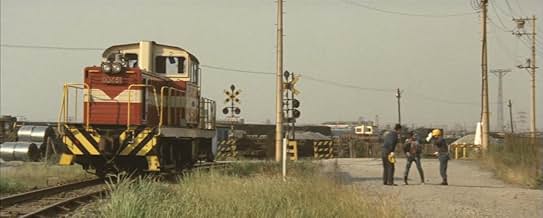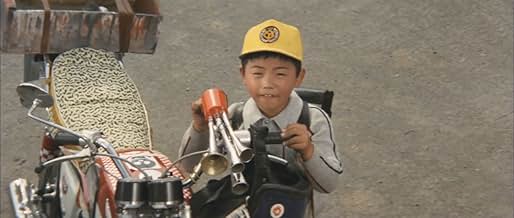अपनी भाषा में प्लॉट जोड़ेंA latchkey child living in the industrial city of Kawasaki confronts his loneliness through his escapist dreams of Monster Island and friendship with Minilla.A latchkey child living in the industrial city of Kawasaki confronts his loneliness through his escapist dreams of Monster Island and friendship with Minilla.A latchkey child living in the industrial city of Kawasaki confronts his loneliness through his escapist dreams of Monster Island and friendship with Minilla.
- निर्देशक
- लेखक
- स्टार
- पुरस्कार
- कुल 1 नामांकन
- Minira
- (Japanese-language version)
- (वॉइस)
- Minira
- (Japanese-language version)
- (वॉइस)
- Gabara
- (बिना क्रेडिट के)
फ़ीचर्ड समीक्षाएं
One film is a kid's visit to Monster Island, where he witnesses a compilation of fight scenes from "Son of Godzilla" and "G. Vs. the Sea Monster". Some of this footage looks like out-take or alternate take material; the whole Gabara episode may well have been intended for "Son of" and excised, in the way that "Frankenstein Conquers the World" was to include a fight with a giant squid, some footage of which finding its way into "King Kong Vs. Godzilla".
The second film is a story of a young boy of the working class in an overly-industrialized modern Japan, neglected by his parents, bullied in school, who finds himself kidnapped by a gang of bank robbers and has to learn courage and wit in order to deal with his situation.
The first film is notorious as a "stock-footage" fiasco with a talking monster. The edits only make evident weaknesses in the original material.
The second film is staggeringly depressing. When I first saw this, I wasn't sure how to respond, because certainly I wasn't looking for a grim expose of industrialized Japan. But the first episodes of this storyline, with its backdrop of empty lots and factory smokestacks billowing in the background, add up to a truly unpleasant experience.
Finally, at the center of all this is one of the more annoying child actors of the period. Hard to identify with, and easy to wish away, I feel no sympathy with him at all as an individual, only as representative of the thousands of neglected children like him.
It should be noted that the stock-footage here was filmed by the 'other Godzilla director', Jun Fukuda - so why does Ishiro Honda use it, why not use his own Godzilla material? A real enigma of a film, part overly serious tragicomedy, part self-lacerating rip-off.
Obviously not recommended except for Godzilla completists.
the most interesting of these side stories involves the boy's friend and neighbour, the typical mussy-haired scientist-tinkerer we find in most Godzilla films. In one scene worth the price of the movie (which I got on VHS at Giant Tiger for $4) our friendly neighbourhood scientist demonstrates his new invention, an integrated monitor and keyboard desktop computer. Keep in mind this is 1968/69, Xerox PARC was only just starting to toy with such ideas in a strictly-business domain, but here in Godzilla-land they are, as usual, decades ahead of the rest of us: IIRC, the boy recommends re-tooling the workstation ... so it will play not just one, but a variety of games! Toho invented the XBox! Back to the movie, it IS possible for older audiences to watch it, but you do need to suspend your belief just a bit more than the usual acceptance of 100-foot monsters.
So ... should a baby-gozilla be 4 feet high, blow smoke-rings and walk and talk? Absolutely. The key to watching this film is just as another reviewer noted, by keeping in mind that the entire film occurs inside the daydreams of a very young person. Given that, it all makes perfect sense, the plot, the dialog, the flashbacks and everything, and if you happen to actually BE a very young person, then it not only makes sense, but it enters your own life.
We were setting place-mats and pillows for Minya for months after they first watched this movie.
Minya fans will also be happy to know that the diminutive atomic monster returns as a principle character in the 2004 Final Wars, albeit with a non-speaking part :)
Here, let me give you all the run-down:
Sound Effects: US version- They sound very weird and almost muted out. And the sounds that Ichiro's voice actress keeps making does not go with what the child star is saying.
Sound Effects: Japanese version- Ah, now that I can hear better. I don't need to tune up the volume now!
Picture: US version- Pan and Scan.
Picture: Japanese version- Widescreen format. You get to see alot more on what's going on.
Music: US version- Probably one of the few descent things. The theme song is quite upbeat and quite unusual. However, the music may be good, but does it really sound like a Kaiju Eiga soundtrack though?
Music: Japanese Version- Some have thought of it being cutesy poo, but I liked it. Ichiro's actor's voice is soooooo cute! Fits the movie more.
And most importantly......
Minilla's voice: US version- GAAAAAAH! No, no, no, no, no! Is this what gave the Barney creator's their sinister idea? The voice actor gave Minilla-kun no justice!
Minilla's voice: Japanese version- Ahhhh, now that is BETTER! Sounds cuter and more child like. More fitting for Minilla. NOTE: The late Michiko Hirai, who voiced Sally Yumeno in an old school anime series called "Mahô tsukai Sally (aka. Witch girl Sally) did Minilla's voice in Japan.
Overall: Get the Japanese version. It is more pleasant.
Latterday entry in Honda's series of childish monster films, quickly shuttled to television. The film is kiddie/boy scout-oriented, with "Ultraman"-styled monster fights on Monster Island, where biggies from "Destroy All Monsters" congregate, including Godzilla, Manda, a new-styled Gamera and Minya, Godzilla's son who is boy-sized this time out. The story is dream-style and weak on plot, with flashy, pointless, modernistic techniu.
क्या आपको पता है
- ट्रिवियाDirector Ishirô Honda intended the movie to have a somber ending, but was forced by Toho to add the more cheerful final sequence in which Ichiro goes to school with the children. When the movie was re-released on home video during the 80s, Honda removed this scene, so the movie ends with Ichiro's mother crying due to not being able to spend more time with her son.
- गूफ़A few of the jet aircraft that Godzilla are shown to bounce off his chest. However, an actual jet would be destroyed upon impact. This takes place during a dream sequence, so reality may not be the truth.
- भाव
Minira: Oh, it's you.
Ichiro Miki: What are you doing?
Minira: Nothing, I have no friends.
Ichiro Miki: Then you're just like me.
Minira: Why did you come back?
Ichiro Miki: You said you'd help me climb up on Godzilla's back.
Minira: Oh, right. I wonder where he is now?
Ichiro Miki: You're not with him all the time?
Minira: No, he gets mad.
Ichiro Miki: Why?
Minira: Godzilla says I have to learn to fight my own battles.
Ichiro Miki: He's tough on you, huh?
- इसके अलावा अन्य वर्जनThe Japanese laserdisc is uncut and fully letterboxed (2:35:1)
- कनेक्शनEdited from Kyô mo ware ôzora ni ari (1964)
- साउंडट्रैकKaiju Machi
Performed by Tomonori Yazaki
(Japanese Version Only)
टॉप पसंद
- How long is All Monsters Attack?Alexa द्वारा संचालित
विवरण
- चलने की अवधि1 घंटा 9 मिनट
- ध्वनि मिश्रण
- पक्ष अनुपात
- 2.35 : 1
इस पेज में योगदान दें





























